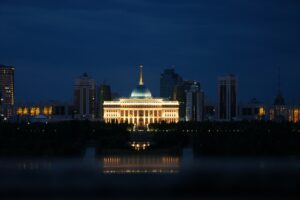
Kazakhstan and Uzbekistan push for trade liberalization
In a significant move towards economic integration, Kazakhstan and Uzbekistan are intensifying efforts to reduce trade barriers between their countries. This initiative aims to more than double their bilateral trade volume in the coming years. The drive to foster closer economic ties was highlighted during a recent meeting between Kazakh Prime Minister Olzhas Bektenov and his Uzbek counterpart, Abdulla Aripov, where they discussed various measures to streamline customs procedures and improve trade logistics.
The two Central Asian nations are part of a broader regional effort to create a unified market, an objective supported by the B5+1 process. This U.S.-backed initiative, launched in March 2024, aims to foster regional free trade and diversify export routes among Kazakhstan, Kyrgyzstan, Tajikistan, Turkmenistan, and Uzbekistan. Simplifying customs procedures, protecting property rights, and resolving commercial disputes are key components of this strategy.
Recent diplomatic activities underscore the commitment to this vision. In April, Uzbek President Shavkat Mirziyoyev and Tajik President Emomali Rahmon signed 28 interstate agreements, including those aimed at streamlining customs procedures and protecting industrial property rights. Additionally, Uzbekistan and Tajikistan are working on creating a free trade zone and constructing a logistics hub in the Ferghana Valley, reflecting a strong push towards enhanced trade cooperation.
Kazakhstan has also been active in this sphere. President Kassym-Jomart Tokayev signed several bilateral agreements with Kyrgyz President Sadyr Japarov, focusing on easing cross-border movements and boosting the exchange of manufactured goods. Digitalizing customs operations at border crossings is a major part of these efforts, expected to be completed by 2028.
The moves by Kazakhstan and Uzbekistan to reduce trade barriers are seen as part of a larger strategy to make the Middle Corridor trade route a lucrative option for regional governments and businesses. This corridor is envisioned to attract more Western trade and investment by reducing non-geographical barriers that impede the flow of goods and people across borders.
However, the road to regional economic integration is not without challenges. For instance, trade turnover between Tajikistan and Kyrgyzstan has been significantly low, exacerbated by border disputes and sporadic armed clashes. Moreover, Russia, wary of the potential for freer trade networks bypassing its territory, has shown skepticism towards these regional initiatives.
Despite these hurdles, the agreements and diplomatic efforts signal a strong commitment by Central Asian leaders to enhance regional trade cooperation. The progress made in reducing trade barriers between Kazakhstan and Uzbekistan marks a crucial step towards achieving a more interconnected and economically vibrant Central Asia

